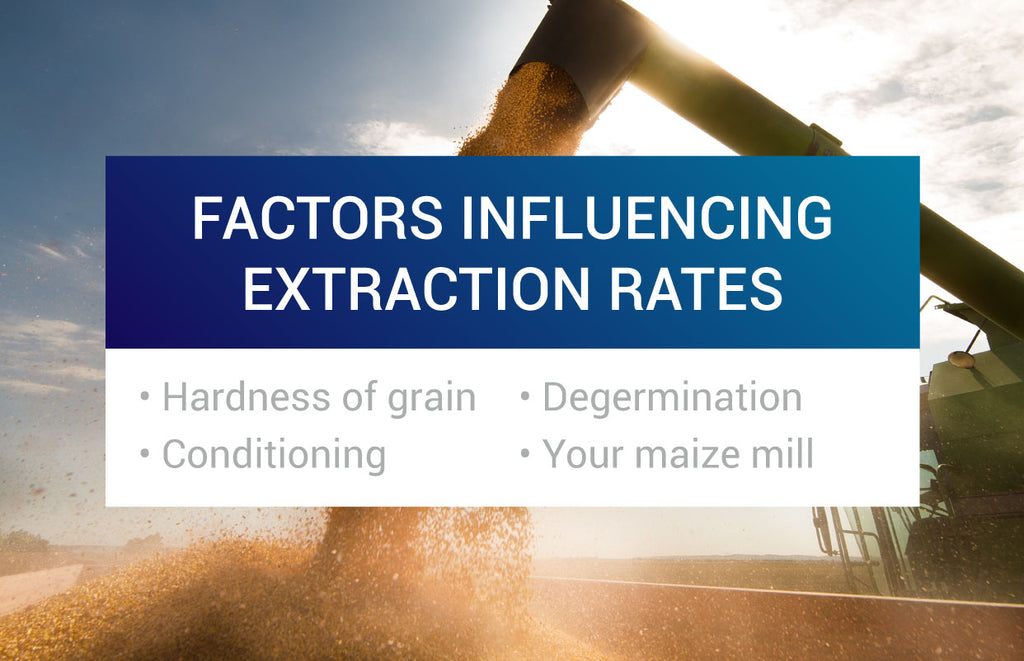ASK THE MOST IMPORTANT QUESTION FIRST
You’ve realised that maize milling as a business opportunity has massive potential, especially here in Africa. We love maize meal in all its forms: putu, reHupfu, ugali, mieliepap. It’s affordable food, plays an increasingly important role in food security and it is a beloved part of many of our local food cultures... It is your next big move.
As a potential maize mill owner, extraction rate should be a key consideration in your choice of maize mill. It’s directly linked to future profitability.
Your first question when researching a suitable maize mill should be: What is the extraction rate?
If you are still a bit unclear about what extraction rate means, don't worry, you are in the right place.

The maize kernel has three main parts, i.e. endosperm, bran, and germ. The endosperm makes up about 84% of the kernel. This is our target. We want to get as much of the endosperm out of the kernel because this will be what makes up our end product. We want to extract the endosperm through the milling process.
Better extraction means more product and this, in turn, means increased profitability.

Read more about how hardness of grain, conditioning and degermination influences extraction rates.
CHOOSING A MILL
You can have the correct cultivar maize supply lined up from the most ideal climate for growing maize, but if your mill’s extraction rate is not up to standard, you will feel it in your pocket. Selecting a mill purely on price will have a detrimental effect on your long-term profitability if the extraction rate is not optimal. Not only does a Roff mill tick the conditioning and degermination boxes, we manufacture maize mills that have class-leading extraction rates of 70 - 85%*. We have a range of mills with different capacities, have a look here and compare.
 *Quality of maize dependent
*Quality of maize dependent
![]()
CALCULATE YOUR POTENTIAL MAIZE MILLING PROFIT
At Roff, we are passionate believers in African entrepreneurs. Our free profit calculator tool for maize milling entrepreneurs has been designed to help you calculate your success and minimise your risk.
CALCULATE YOUR PROFIT

CALCULATE YOUR POTENTIAL MAIZE MILLING PROFIT
At Roff, we are passionate believers in African entrepreneurs. Our free profit calculator tool for maize milling entrepreneurs has been designed to help you calculate your success and minimise your risk.
CALCULATE YOUR PROFITPROFIT CALCULATOR
While you are on a roll, why don’t you use our profit calculator to get an even clearer idea of your potential future profits. It takes less than 5 minutes. From raw materials, electricity costs, salaries, and even the packaging for the end product, we make sure all expenses are included to give you an accurate result. Take the first step in planning your success.
CONCLUSION
Roff has got your back when it comes to extraction rates. Lucky for you we’re also affordable, we specialise in building maize mills for Africa and have been doing this for almost thirty years.
Depending on your choice of mill, we can have you operational in as little as a month. We offer after-sales and technical support. To quote one of our successful clients, Josua Pietersen: “Roff made every step easy”.







1 comment
Bernard
The information is very resourceful. I will appreciate more since i am planning to explore this field in the near future.
———
Roff Milling replied:
Hi Bernard, we are working on more content, and as the most important part of a milling business you need all the info you can get.
Here are a few more blogs related to extraction rates – https://www.roff.co.za/blogs/blog/tagged/extraction-rates